| Construction Rating: | starstarstarstarstar_border |
| Flight Rating: | starstarstarstarstar |
| Overall Rating: | starstarstarstarstar_border |
| Published: | 2010-06-30 |
| Diameter: | 1.33 inches |
| Length: | 15.60 inches |
| Manufacturer: | Estes  |
| Skill Level: | 1 |
| Style: | Scale |
Matt. The bull pup D12 is a sports scale rocket. I had one that I flew often and lost it on a roof. With the 2010 challenge asking for a duel review, I dusted off two kits from the build pile. Chris Fisher and I are both members of Midland Rocketry and meet up once a month. So he and I both built the kit.
Chris. First up I must thank Matt for giving me the kit. Of course I know it's just so he can score a few more points.
I loved the blister pack, I think it looks far more exciting than the usual plastic bag and cardboard affair.
Although they kits are the same, they came from different releases.
Matt bullpup is from the explorer series - E7000, in a cardboard box
Chris’s bullpup is from the explorer series – E7000, in a blister pack.
Construction:
The parts for the kit consist of:
- Body tube.

- Engine spacer.
- Engine mount tube.
- Launch lug.
- Green engine block.
- Centering rings.
- Die cut balsa sheet.
- Elastic shock cord.
- Plastic tail cone.
- Plastic nose cone.
- 12 inch pre assembled parachute.
- 2 pieces of clay weight.
- Decal sheet.
Matt’s comments on the parts:
The parachute on the instructions in the make it yourself type, with shroud lines, disks and parasheet, mine was the better pre assembled type.
The decal sheet is a peel and stick - I'm pretty sure that the last bullpup I built about 7 years ago had waterslide.
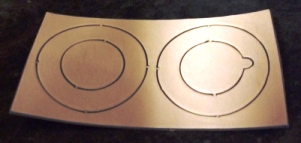 The die cut balsa sheet was not the best quality.
The die cut balsa sheet was not the best quality.
The centering ring sheet is warped, I had to ironed them flat.
The shock cord is far too short, but Estes kits always have too short shock cords.
Chris’s comments on the parts:
Parachute was I think pre-built - didn't pay much attention as always for me. I've a bunch of nice rip-stop nylon chutes and streamers in various sizes on snap swivels, so I just use one of those as appropriate.
I've not put the decals on my rocket yet, but they are peel and stick. Not sure what I prefer, at least I can usually get the peel and stick ones on the rocket in the right place and intact, but they never look as good as water-slide ones.
Centering rings were fine in my kit. Agree with Matt’s comment about the balsa, it was pretty awful, felt very soft.
Matt’s motor mount: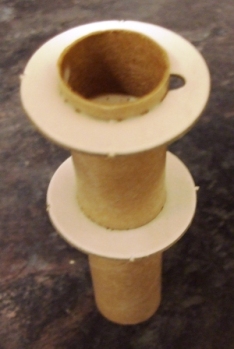
This rocket does not come with an engine hook, which I would have omitted even if there was one as I think it would ruin the look of the rocket.
One of the two rings supplied has a notch removed, where the engine hook could move, this will be for the top of the motor mount as I can then thread a steel leader onto the center of the mount.
White glue was used to glue the rings and engine block into place.
A steel fishing leader has been added to the mount, taped and glued in. I’m increasing using steel fishing leaders instead of tri fold paper anchors, or Kevlar loops. I find that they hold up to ejection charges much better, I have had Kevlar burn through in the past.
Chris’s motor mount:
I opted for a simple loop of Kevlar round the top centering ring on the motor mount, with loads of glue. I realised too late that I had attached the ring with the slot to the wrong end of the mount (doh!), so simply cut a new notch on the edge and pushed the Kevlar through that.
Matt’s tail cone:
The tail cone has to be cut from a plastic part. I remember this being a bit difficult last time, but since then I have purchased a razor saw, so the cutting was much smoother. The ends were then sanded down on sand paper.
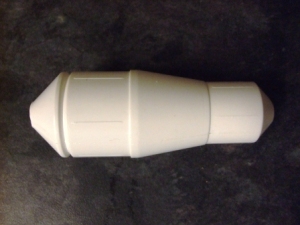
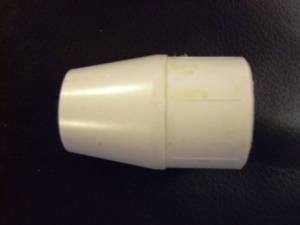
The motor mount was been glued into position, with the boat tail slipped over later. There is a seam where the boat tail and the BT join, it's not much but I’ve coated the seam and most of the rear with model filler, which sands down smooth. As I’ve used a fresh tube, the filler came out a bit watery, so I had to sand and refill to remove all trace of the transition.
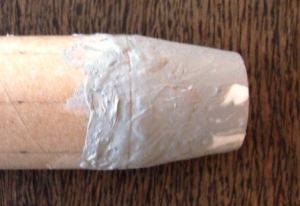
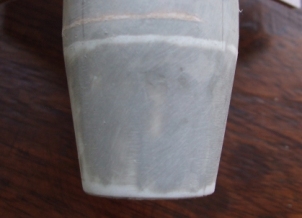
Chris’s tail cone:
I'm useless at cutting these kind of things usually, but I'm quite pleased with how this one come out. Very cunning use, of what looks like a transition designed for another rocket and reused as the tail cone for this.
Matt’s fins:
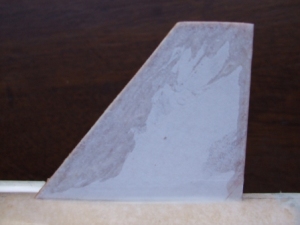 I decided to leave the leading and trailing edges square. I used sticky backed paper to laminate the fins. Not that the fins needed to be laminated for strength, but paper lamination does completely remove any sign of grain. To stop the paper from delaminating I coated the edges with thin CA glue. I used CA gel to tack the fins in place, and then added three fillets of wood glue over a day.
I decided to leave the leading and trailing edges square. I used sticky backed paper to laminate the fins. Not that the fins needed to be laminated for strength, but paper lamination does completely remove any sign of grain. To stop the paper from delaminating I coated the edges with thin CA glue. I used CA gel to tack the fins in place, and then added three fillets of wood glue over a day.
Front fins have been added using the TLAR (that looks about right) method. Normally with split fins I use two rulers and clamps to align them properly, but given the size of the forward fins I did not bother. I then added beads of white glue to all edges, as well as adding two fillets to the joins.
Chris’s fins:
I was feeling lazy and the fins are so small, that all I did was sand them down a bit, no filler, no paper, no rounding. I did find that the canard fins were so tiny, that they simply stuck to any glue on your fingers rather than the rocket. So I now have 5 fingers and 2 fins on each hand.
Matt’s rest of the build:
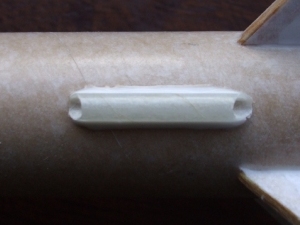 Launch lug had its ends trimmed at an angle to reduce drag. Like the fins it was CA tacked and wood glue filleted.
Launch lug had its ends trimmed at an angle to reduce drag. Like the fins it was CA tacked and wood glue filleted.
Clay worms were put in the nose cone. I opened up the base of the nose cone so I could use a rod to stamp the clay into the top of the cone. Coated the inside of the top of the BT with CA to strengthen that up a tad. Added a length of elastic to the leader, used three foot of sewing elastic.
Chris’s rest of the build:
Didn't know the trick with trimming the launch lug, will do that next build.
Finishing:
Matt.
 Finishing the bullpup is every simple. The entire rocket has to be white; so the normal few coats of primer and then white spray paint went on the rocket. Next came the decals, and this is where I really have to lower the grade for this kit. The stickers are the peel and stick type, which really do spoil the look of the rocket. The first bullpup I built years ago had the waterslide type decals and the model was far better looking then.
Finishing the bullpup is every simple. The entire rocket has to be white; so the normal few coats of primer and then white spray paint went on the rocket. Next came the decals, and this is where I really have to lower the grade for this kit. The stickers are the peel and stick type, which really do spoil the look of the rocket. The first bullpup I built years ago had the waterslide type decals and the model was far better looking then.
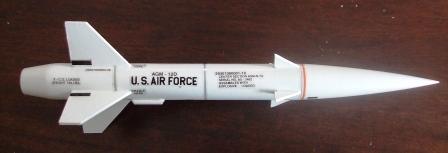 Chris
Chris
Mine just had the usual primer and white gloss. Looks pretty good, and will look great once the decals are on.
Construction Rating: 4 out of 5
Flight:
Matt’s flight comment:
Having flown the previous bullpup several times, I know the rocket to be a good performer. There is plenty of room in the BT for the recovery parachute, and like all Estes kits the supplied elastic shock cord is far too short and needs to be added to by at least 2 foot. On C6 flights the supplied 12 inch parachute can give the rocket a lot of drift. I sensibly went for an A8-3. I like to build up the power on successive flights. My bullpup flew well on the A8, but in my normal luck, managed to land in a water ditch. No damage other than a muddle rocket.
Chris’s flight comment:
Matt really is a great big girl, putting an A8 in his. Of course I had the bravado of essentially having a free rocket, so stuck a C6-5 in mine. Flew really well in a drag race with Matt's. His was first off the pad, but mine obviously streaked away faster. Courtesy of some slack prep, I had failed to actually attach the snap swivel from the chute to the rocket, so had to rely on tumble recovery. Luckily our flying field is quite soft usually, and no damage was done.
Recovery:
Flight Rating: 5 out of 5
Summary:
Matt: A good rocket, good enough that when I lost my first, I went out and got another. Not a perfect scale rocket but still has a good look to it and it performs well.
Chris: I actually like this way more than I expected, so much so that the larger PML variants are looming large in my future shopping list. And it looks like it will be a good flyer.
Overall Rating: 4 out of 5
Other Reviews
- Estes Bull Pup 12D By Jon Revelle
Brief: This is a sport scale version of the Air Force's Bullpup Missile. A skill level 2 rocket but not that hard. It has been around for quite a bit now. Construction: The kit comes in either a box or a bag (nowadays it comes in a bag) and mine had all of the parts. You get: Nose Cone Body Tube Sheet of balsa Tail Cone Clay Nose Weight Centering Rings ...
- Estes Bull Pup 12D By Frank Ross
( Contributed - by Frank Ross - 11/01/00) Brief: Upsized motor to 24mm. Modifications: The modification is fairly simple. I sanded down the plastic tail cone until the opening was the same as the inner diameter of a BT-50 motor mount tube. I used a BT-50 to BT-55 centering ring for the forward end of the motor mount and epoxied the aft end of the motor mount into the tail cone, being ...
- Estes Bull Pup 12D By Doyle Tatum
(by Doyle Tatum) I purchased this model about 6 months ago and with the upcoming SoAR Birthday celebration launch (the first rocket to fly at a SoAR launch was a Bull Pup) and the discussion of converting to 24mm, on RMR, I decided to assemble the rocket. I assembled the rocket per the instructions with the following additions and exceptions: I cut a 24mm tube and then sanded the ...
- Estes Bull Pup 12D By John Yurcina
Brief This is a very well designed sport scale version of the USAF Bull Pup 12D. You should be able to build this rocket if you have a couple other rockets under your belt. Construction The first thing I noticed was that this model was in a box. Some Estes kits are in flimsy plastic bags, which makes the parts prone to creases and such. I opened up the box, and all the parts were ...
 |
 |
Flights
 |
 |
C.T. (January 1, 2001)
 Got at Walmart for $9.99. Good Kit. It's a little tough to align for a beginner. A lot of people tore those little forward fins off because they make it unstable, but mine flies great. Straight as an arrow. However, I also added extra nose weight to be on the safe side. I made exactly according to instructions and painting according to box and it turned out rather nicely. Looks really nice a great sport scale kit I used this at NARAM-40 when I could not use my blackbird.
Got at Walmart for $9.99. Good Kit. It's a little tough to align for a beginner. A lot of people tore those little forward fins off because they make it unstable, but mine flies great. Straight as an arrow. However, I also added extra nose weight to be on the safe side. I made exactly according to instructions and painting according to box and it turned out rather nicely. Looks really nice a great sport scale kit I used this at NARAM-40 when I could not use my blackbird.
M.T.S. (January 1, 2001)
M.K.H. (October 27, 2001)
W.S. (January 18, 2002)
K.R.E. (June 16, 2003)
D.B. (February 23, 2004)
R.L. (February 27, 2004)
K. W. (July 26, 2004)
Willy (September 26, 2004)
K.G.D. (October 4, 2004)
W.M.R. (October 27, 2004)
C.M. (February 5, 2007)
S.W.M. (March 22, 2008)
Sponsored Ads
 |
 |
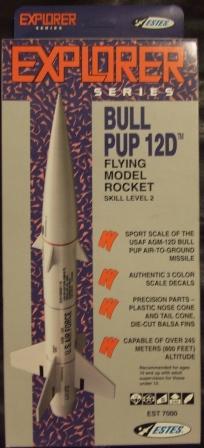 Brief:
Brief:











A.G. (November 1, 2000)